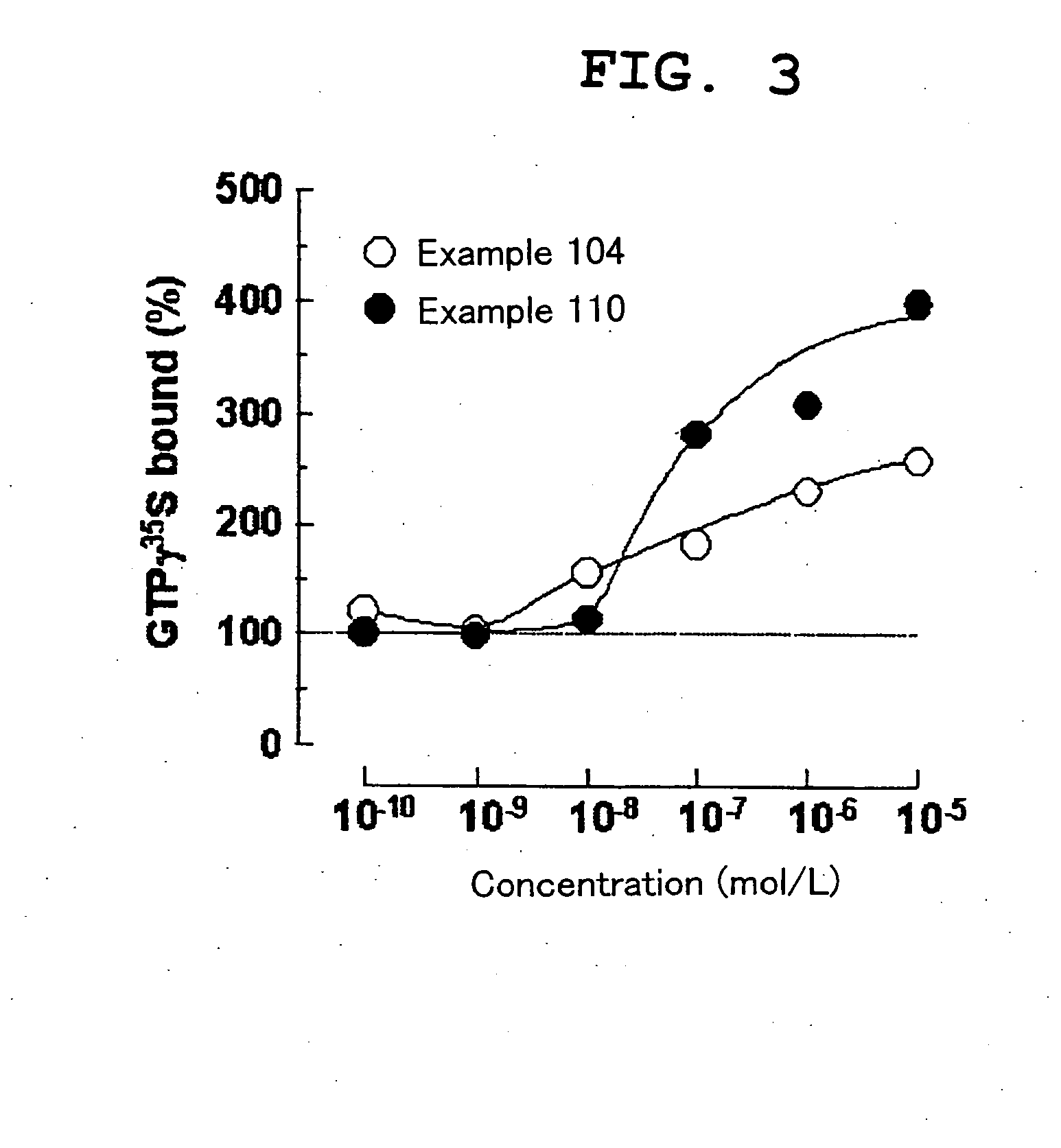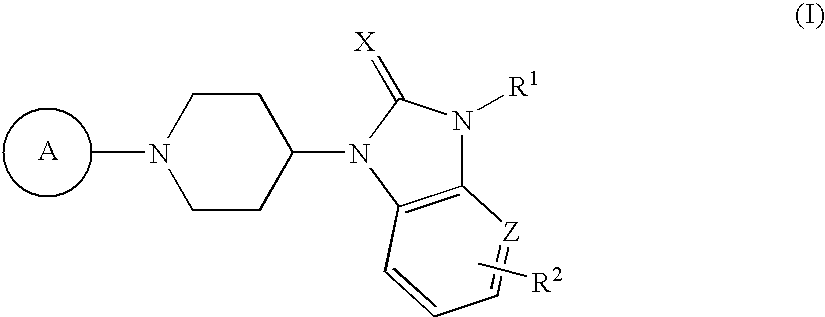Benzimidazole compound and pharmaceutical use thereof
- Summary
- Abstract
- Description
- Claims
- Application Information
AI Technical Summary
Benefits of technology
Problems solved by technology
Method used
Image
Examples
example 1
1-[1-(1,2,3,4-tetrahydronaphthalen-1-yl)piperidin-4-yl]-1,3-dihydro-2H-benzimidazol-2-one
[0183]α-Tetralone (1.0 g) was dissolved in ethanol (20 ml), sodium borohydride (0.26 g) was added, and the mixture was stirred at room temperature for 30 min. 1N Hydrochloric acid (10 ml) was added to cease the reaction. Ethanol was evaporated, and the aqueous solution was extracted with chloroform. The extract was dried over anhydrous magnesium sulfate, and concentrated. The obtained residue was dissolved in chloroform (10 ml), thionyl chloride (1.0 ml) was added, and the mixture was stirred with heating under reflux for 30 min. Chloroform and thionyl chloride were evaporated under reduced pressure, and the residue was dissolved in dimethylformamide (10 ml). Potassium carbonate (2.5 g), 4-(2-keto-1-benzimidazolinyl)piperidine (0.50 g) and sodium iodide (0.69 g) were added, and the mixture was stirred at 150° C. for 2 hr. After cooling to room temperature, water was added, and the mixture was ex...
example 2
2-{3-[1-(1,2,3,4-tetrahydronaphthalen-1-yl)piperidin-4-yl]-2,3-dihydro-2-oxo-benzimidazol-1-yl}-N-methylacetamide
[0186]1-[1-(1,2,3,4-Tetrahydronaphthalen-1-yl)piperidin-4-yl]-1,3-dihydro-2H-benzimidazol-2-one (476 mg) was dissolved in tetrahydrofuran (5 ml), 60% sodium hydride (66 mg) was added, and the suspension was stirred at 50° C. for 30 min. After cooling to room temperature, ethyl bromoacetate (0.167 ml) was added, and the mixture was stirred for 1 hr. 40% Methylamine-methanol solution (5 ml) was added, the mixture was stirred at room temperature for 1 hr, and the reaction mixture was concentrated under reduced pressure. The obtained residue was purified by silica gel column chromatography (chloroform / methanol) to give the title compound (567 mg) as a pale-yellow powder.
[0187]1H-NMR (CDCl3) δTMS:1.67-1.74 (m, 3H), 1.93-2.04 (m, 3H), 2.27-2.32 (m, 2H), 2.60 (m, 1H), 2.71-2.86 (m, 7H), 3.02 (m, 1H), 3.92 (m, 1H), 4.35 (m, 1H), 4.51 (s, 2H), 6.18 (brs, 1H), 7.06-7.26 (m, 6H), 7....
example 3
(R)-1-[1-(1,2,3,4-tetrahydronaphthalen-1-yl)piperidin-4-yl]-1,3-dihydro-2H-benzimidazol-2-one
[0189](1) (S)-(+)-1,2,3,4-Tetrahydro-1-naphthol (1.0 g) and diphenylphosphoryl azide (2.23 g) were dissolved in toluene (10 ml), diazabicycloundecene (1.23 g) was added, and the mixture was stirred at room temperature for 6 hr. The reaction mixture was poured into water, the mixture was extracted with toluene, and the combined organic layer was washed with 1N hydrochloric acid and water, dried over anhydrous magnesium sulfate, and concentrated. The residue was purified by silica gel column chromatography (hexane / ethyl acetate) to give (R)-1-azido-1,2,3,4-tetrahydronaphthalene (1.20 g) as a colorless oil.
[0190]1H-NMR (CDCl3) δTMS1.81-1.84 (m, 1H), 1.93-2.04 (m, 3H), 2.77-2.85 (m, 2H), 4.57 (m, 1H), 7.14-7.29 (m, 4H)
(2) (R)-1-Azido-1,2,3,4-tetrahydronaphthalene (1.20 g) was dissolved in a mixed solvent (11 ml) of tetrahydrofuran / water (10:1), triphenylphosphine (2.35 g) was added, and the mixt...
PUM
| Property | Measurement | Unit |
|---|---|---|
| Stability | aaaaa | aaaaa |
| Selectivity | aaaaa | aaaaa |
| Bioavailability | aaaaa | aaaaa |
Abstract
Description
Claims
Application Information
 Login to View More
Login to View More - R&D
- Intellectual Property
- Life Sciences
- Materials
- Tech Scout
- Unparalleled Data Quality
- Higher Quality Content
- 60% Fewer Hallucinations
Browse by: Latest US Patents, China's latest patents, Technical Efficacy Thesaurus, Application Domain, Technology Topic, Popular Technical Reports.
© 2025 PatSnap. All rights reserved.Legal|Privacy policy|Modern Slavery Act Transparency Statement|Sitemap|About US| Contact US: help@patsnap.com



